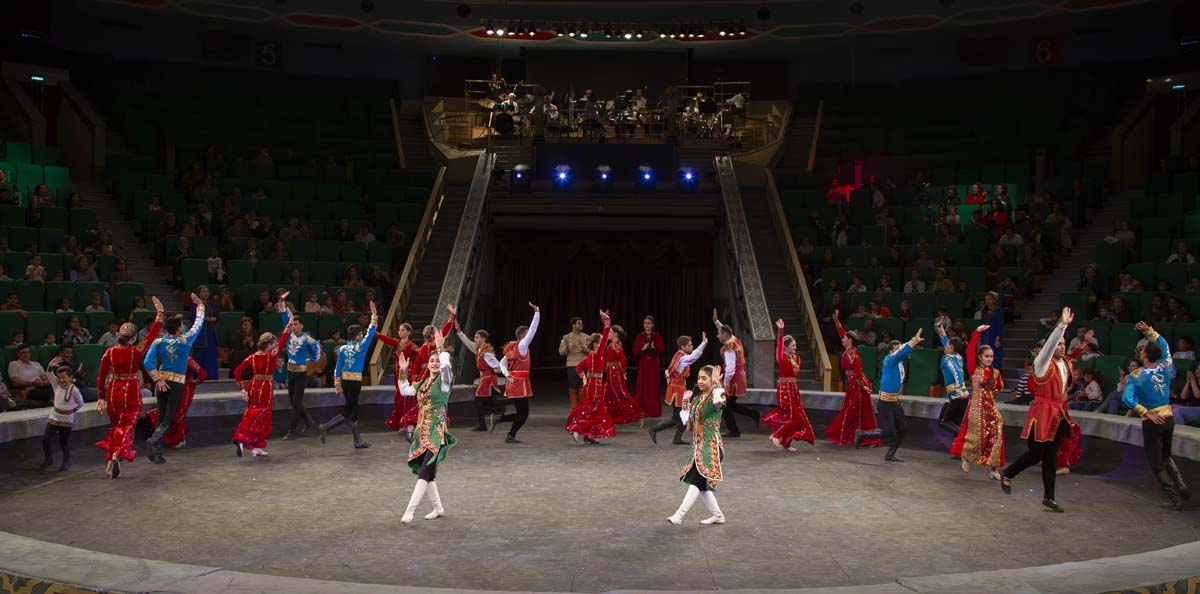 The Museum of the State Cultural Centre of Turkmenistan presented renewed exposition of the halls dedicated to history and culture of the Middle Ages. Ovezmuhammet Mammethurov, the Director of the Museum speaks about its features for of attraction of interest of the public, especially the youth, to national heritage:
The Museum of the State Cultural Centre of Turkmenistan presented renewed exposition of the halls dedicated to history and culture of the Middle Ages. Ovezmuhammet Mammethurov, the Director of the Museum speaks about its features for of attraction of interest of the public, especially the youth, to national heritage:
Current year of 2016, which is announced as a Year of Honour of heritage and Transformation of the Motherland, was very intensive and at the same time very fruitful for the personnel of the museum. Finishing the year, we are planning to continue active work for popularization of national historical and cultural heritage in 2017. The doors of our museums, the same as before, will be wide open for all who wish to visit the treasury of the spirituality.
Many of the values, which are kept in the funds of the State museum, are known around the world. The Head of the State gave us all opportunities and conditions for productive work. We will continue the activity for study and popularization of the heritage.
Speaking of the outcomes of the year, I would like to highlight that number of exhibitions were organized by the initiative of President Gurbanguly Berdimuhamedov in the country and abroad. One of them was expanded in New York Metropolitan Museum in USA. The exhibition of the rarities of the Seljuks age from the collection of our museum worked during three and half months. It was the first topical exhibition in our practice, which was displayed for such long time.
Currently, the collection of the State Museum, related to the period of ancient Margush country, is under preparation for exhibition in the cities of Germany in 2018. This will be a travelling exhibition.
Current exhibition, dedicated to one of the significant periods of native history, gives expanded presentation of the Middle Ages. All exhibits are from our funds, but having altered compositional style and decoration, we made an accent on rare subjects, which are typical for remarkable events of that time and giving opportunities to the visitors to be imbued with the atmosphere of mediaeval history and culture and to value the level of arts and crafts.
The period starts from the III AC and last until the XVII century. This age is divided into the Dark Ages, the Renaissance and the Late Middle Ages. Having separated this periods, we designed two exhibition halls.
We reproduced the dioramas with view of Merv in the V and XII centuries, where unprecedented prosperity of Turkmen land took place. In XII, Merv was one of the largest cities in the world. the largest libraries, madrasahs, science and educational centres were in the city with more than million population. Intensive cultural processes were happening in that period what is evidenced by remained manuscripts of outstanding scientists and poets who lived during those days as well as by mediaeval monuments, where the Sultan Sanjar Mausoleum occupies special place. Having reproduced an authentic view of the surroundings according to the drawings of the archaeologists, we made a diorama of the whole complex of the buildings and construction.
Besides, we reproduced the views of Merv in different historical ages. Turkmen people established more than 70 countries in the Middle Ages. We felt necessary to reflect this in renewed exposition, having presented the part of Turkmen counties (bgliks) in Anatoly, information about Turkmen states Garagoyunly and Akgoyunly and about the largest Turkmen state of those times - the Ottoman Empire. Our ancestors established the states in India and other regions, which is displayed by archaeological findings of the first hall.
We used another approach while decorating the second hall. Its exhibits speak of the Northern, Western, Southern and Eastern Turkmenistan as well as about the areas where the Great Silk Road used to run. There are many information about the state of Kunyaurgench turkmens in the north of Turkmenistan, about the life of Khoresm shakhs, ancient city Gurganj (Kunyaurgench today), about the monuments and discovered items. Rich visual materials like dioramas, illustrations and photos was used to demonstrate this.
The Western Turkmenistan is also very interesting. The area around ancient Dehistan is rich with historical values. Though the archaeologists did not study this region completely, it is very rich with historical findings and archaeological monuments, what is reflected in our exposition.
Switching over to the Southern Turkmenistan, this part is represented by the findings discovered in Abiverd, New, Old and Medieval Nissa as well as in Annau including the materials about original Seyit Jemaletdin Mosque.
Speaking of the Eastern Turkmenistan, we gave the information on the city of Amul. It is known that the Great Silk Road used to run there and the territory of the country was its main link. Going to both directions, the route transited Turkmen cities what is evidenced by historical exhibits like maps, written sources and various items.
Realization of this large-scale project required laborious efforts and became a good lesson for us. We will continue this important work in the future. Despite the end of 2016, the honour of the heritage and transformation of the motherland will be the priorities of our work in the future as cultural, spiritual heritage of the nation is the generator of uninterrupted evolutionary transformations in modern society






